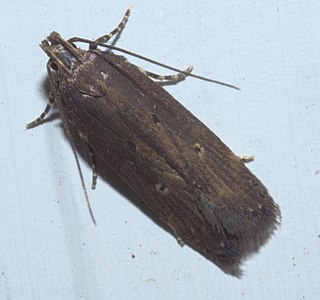
Chionodes is a genus of moths of the family Gelechiidae. It is distributed throughout much of the world. The larvae of many species use the Douglas fir as a host plant.
Chionodes petalumensis is a species of moth in the family Gelechiidae. It is found in North America from southern British Columbia to California, Arizona and Colorado.
Chionodes chrysopyla is a moth in the family Gelechiidae. It is found in North America, where it has been recorded from California, Arizona, Washington and British Columbia.

Chionodes discoocellella, the eyeringed chionodes moth, is a moth in the family Gelechiidae. It is found in the United States, where it has been recorded from Maine to South Dakota, Florida, Texas and Colorado.
Chionodes lophosella is a moth in the family Gelechiidae. It is found in North America, where it has been recorded from Washington to California.

Chionodes periculella is a moth in the family Gelechiidae. It is found in North America, where it has been recorded from British Columbia, Washington, California and Oregon.

Chionodes pseudofondella is a moth in the family Gelechiidae. It is found in North America, where it has been recorded from New Hampshire, southern Ontario, Nebraska, Arkansas and North Carolina.
Chionodes retiniella is a moth in the family Gelechiidae first described by William Barnes and August Busck in 1920. It is found in North America, where it has been recorded from Idaho, Wyoming, Nevada, British Columbia, Washington, Colorado, New Mexico, Arizona and California.
Chionodes trichostola is a moth in the family Gelechiidae. It is found in North America, where it has been recorded from south-western British Columbia to California, Utah, Colorado, Arizona and Texas.
Chionodes lacticoma is a moth in the family Gelechiidae. It is found in Peru.
Chionodes litigiosa is a moth in the family Gelechiidae. It is found in Ecuador.
Chionodes pentadora is a moth in the family Gelechiidae. It is found in French Guiana.
Chionodes argosema is a moth in the family Gelechiidae. It is found in Ecuador.
Chionodes consona is a moth in the family Gelechiidae. It is found in Peru.
Chionodes eburata is a moth in the family Gelechiidae. It is found in Colombia.
Chionodes pleroma is a moth in the family Gelechiidae. It is found in Mexico.
Chionodes creberrima is a moth in the family Gelechiidae. It is found in Mexico (Guerrero).
Chionodes cacoderma is a moth in the family Gelechiidae. It is found in Mexico (Guerrero).
Chionodes donatella is a moth in the family Gelechiidae. It is found in Florida, Jamaica and Cuba.
Chionodes chlorocephala is a moth in the family Gelechiidae. It is found in North America, where it has been recorded from New Mexico, California and Mexico.



